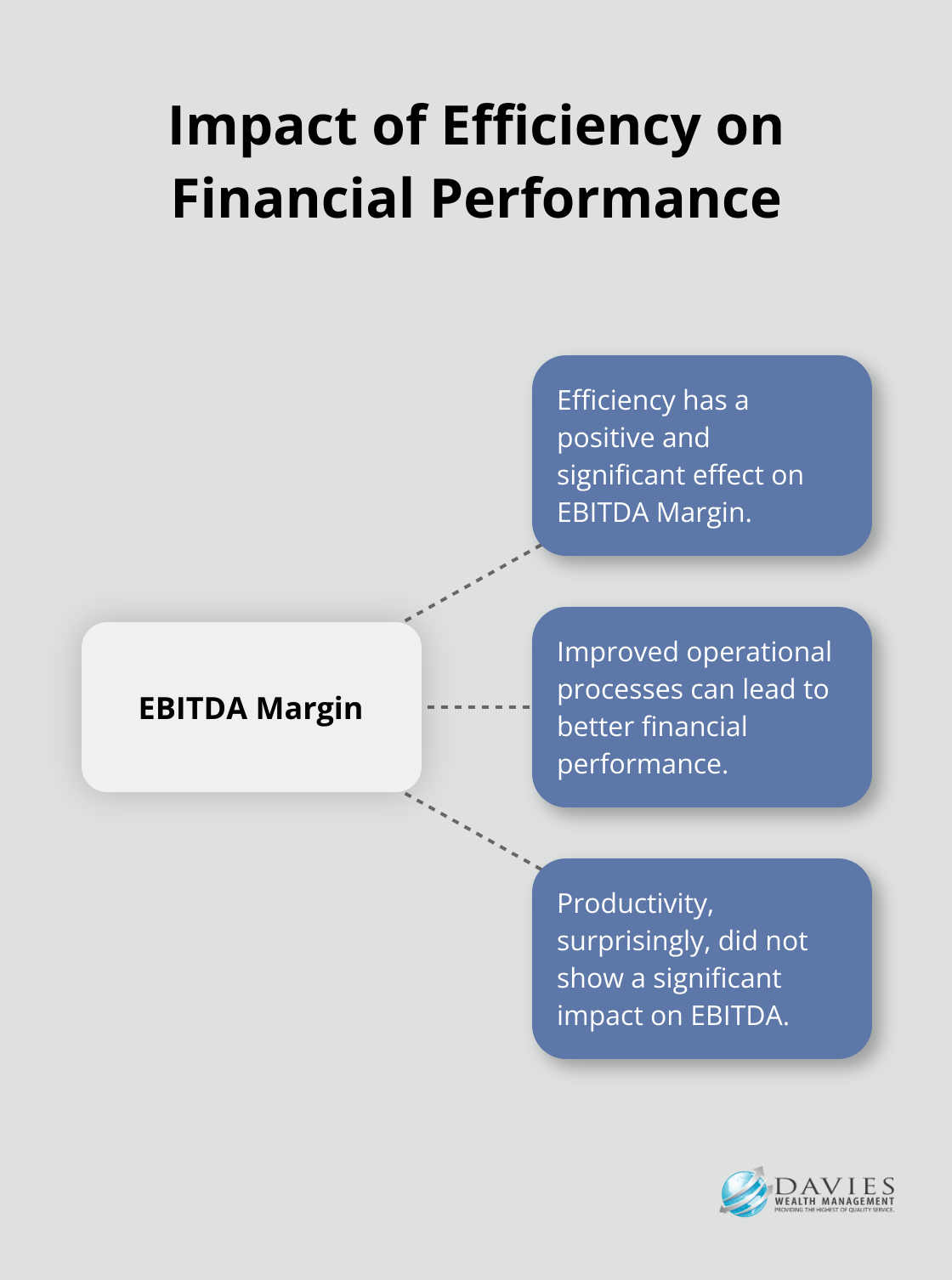At Davies Wealth Management, we understand the critical role of strategic planning for finance departments in driving business success. A well-crafted financial strategy can transform your organization’s financial health and propel growth.
In this post, we’ll guide you through the essential steps to create a robust strategic plan for your finance department. From assessing your current financial status to implementing and monitoring your plan, we’ll provide practical insights to help you achieve your financial objectives.
What’s Your Financial Starting Point?
Examine Your Financial Statements
At Davies Wealth Management, we know that creating a strategic plan for your finance department starts with a clear understanding of your current position. This initial assessment forms the foundation for all future financial decisions and strategies.
Start by thoroughly examining your balance sheet, income statement, and cash flow statement. These documents provide a snapshot of your company’s financial health. Focus on key metrics such as revenue growth, profit margins, and debt-to-equity ratio. Forbes reports that organizations with robust HR practices are 2.5 times more likely to be top performers in their industries.
Perform a Financial SWOT Analysis
Next, conduct a comprehensive SWOT analysis focused on your financial position. This involves identifying your financial strengths (e.g., strong cash reserves), weaknesses (e.g., high operational costs), opportunities (e.g., potential new revenue streams), and threats (e.g., increasing competition).
Define Clear Financial Objectives
With a solid understanding of your current position, it’s time to define your financial goals. These should be specific, measurable, and time-bound. For example, you might set a goal to increase revenue by 15% within the next fiscal year or reduce operational costs by 10% over the next six months. A study from Harvard Business School found that people who set clear and measurable goals are 42% more likely to reach them than those who don’t.

Tailor Goals to Your Unique Circumstances
At Davies Wealth Management, we specialize in helping businesses set realistic and achievable financial goals. Our expertise in working with professional athletes has taught us the importance of tailoring financial objectives to unique circumstances and timelines. This approach applies to all businesses, regardless of their industry or size.
Prepare for the Next Steps
A thorough assessment of your current financial status and clear goal-setting lays the groundwork for a strategic plan that will drive your finance department towards success. With this foundation in place, you’re ready to move on to developing key strategies and initiatives that will help you achieve these objectives.
How to Craft Winning Financial Strategies
At Davies Wealth Management, we understand that developing key strategies and initiatives transforms financial goals into reality. This step involves aligning your financial strategies with your overall business objectives, identifying areas for improvement, and prioritizing your efforts for maximum impact.
Align Financial and Business Goals
The first step in crafting winning financial strategies is to ensure they sync with your company’s broader objectives. For instance, if your business plans to expand into new markets, your financial strategy should focus on securing the necessary capital and managing the associated risks.
A recent study proposes and validates a new industry taxonomy to understand the use of IT that generates superior economic returns. This alignment ensures that every financial decision supports your company’s growth and success.
Identify Cost Reduction and Revenue Growth Opportunities
It’s essential to pinpoint areas where you can cut costs and boost revenue. This process often involves a detailed analysis of your operations and market position.
For cost reduction, consider:
- Streamline processes to improve efficiency
- Negotiate better terms with suppliers
- Implement energy-saving measures
For revenue growth, explore:
- Develop new products or services
- Expand into new markets or customer segments
- Improve your pricing strategy
A recent study showed that efficiency had a positive and significant effect on EBITDA Margin, while productivity did not affect EBITDA.

Prioritize High-Impact Initiatives
With a list of potential strategies, the next step is to prioritize. We recommend using a matrix that considers both the potential impact and the feasibility of each initiative.
High-impact, high-feasibility initiatives should top your priority list. These are the “quick wins” that can provide immediate benefits with relatively little effort or risk.
Schedule medium-impact or medium-feasibility initiatives for implementation in the medium term, while you might put low-impact or low-feasibility initiatives on hold or reconsider them.
Prioritization isn’t a one-time event. You should regularly reassess your initiatives as market conditions change and new opportunities arise. This flexibility is particularly important for clients in professional sports (where career timelines can be unpredictable).
Leverage Technology for Financial Strategy
In today’s digital age, leveraging technology can significantly enhance your financial strategy. Consider implementing financial planning software, data analytics tools, or AI-powered forecasting systems. These technologies can provide real-time insights, improve decision-making accuracy, and increase overall efficiency in your finance department.
Recent advancements in AI adoption for financial modeling enable predictive models that reveal unseen patterns and revenue drivers, accelerating mundane tasks.
Foster Cross-Departmental Collaboration
Effective financial strategies often require input and cooperation from various departments within your organization. Try to establish regular communication channels between finance and other key departments (such as sales, marketing, and operations). This collaboration can lead to more comprehensive and effective financial strategies that take into account the needs and insights of the entire organization.
The next step in creating a strategic plan for your finance department involves implementing and monitoring these carefully crafted strategies. Let’s explore how to effectively put your plan into action and track its progress.
How to Execute Your Financial Strategy
At Davies Wealth Management, we know that a strategic plan becomes reality through careful execution. This chapter outlines the steps to implement your financial strategy effectively and monitor its progress.
Assign Clear Responsibilities
The first step in executing your financial strategy involves assigning specific responsibilities to team members. It’s important to be as specific as possible when assigning responsibilities, as this will help to ensure that everyone knows exactly what is expected of them. Each initiative should have a designated owner who takes accountability for its implementation. This clarity prevents confusion and ensures every aspect of your plan has someone driving it forward.
For example, if one of your strategies involves improving cash flow management, you might assign this task to your head of accounts receivable. They would then develop and implement processes to reduce payment cycles and improve collection rates.
Set Realistic Deadlines
Alongside responsibilities, you must establish clear deadlines for each initiative. These timelines create a sense of urgency and provide benchmarks for measuring progress. However, you should ensure these deadlines are realistic and account for the complexity of each task.
A study by the Project Management Institute found that only 40% of projects finish on time. You can significantly improve this statistic within your finance department by setting achievable deadlines and reviewing progress regularly.

Establish Meaningful KPIs
Key Performance Indicators (KPIs) measure the success of your financial strategy. These measures are used like school reports, providing feedback on how things went over a recent period. They should directly relate to your strategic objectives and provide clear insights into your progress.
For instance, if your goal is to improve profitability, relevant KPIs might include gross profit margin, net profit margin, and return on investment (ROI). The Harvard Business Review suggests that companies should focus on no more than 4-10 KPIs to avoid diluting focus and effectiveness.
Implement a Robust Tracking System
To monitor your progress effectively, you need a system for tracking your KPIs and the status of various initiatives. This could be as simple as a shared spreadsheet or as sophisticated as a dedicated financial planning and analysis (FP&A) software.
Many finance departments find that using project management tools (like Asana or Trello) can help visualize progress and keep team members aligned. These tools allow you to create task boards, set deadlines, and track the status of different initiatives in real-time.
Regular Review and Adjustment
Financial strategies aren’t set in stone. Market conditions change, new opportunities arise, and unforeseen challenges emerge. That’s why you must review your progress regularly and adjust your strategy as needed.
We recommend conducting monthly reviews of your KPIs and quarterly deep-dives into your overall strategy. These reviews allow you to identify what works, what doesn’t, and where adjustments are needed. For clients in professional sports, we often conduct these reviews more frequently due to the fast-paced nature of their careers.
The goal isn’t to stick rigidly to your original plan, but to remain flexible and responsive to changing conditions while still moving towards your overall financial objectives. These practices ensure that your financial strategy doesn’t just remain a plan on paper, but becomes a living, breathing part of your organization’s success.
Final Thoughts
A strategic plan for your finance department will drive business success. We at Davies Wealth Management have witnessed how a well-crafted financial strategy transforms an organization’s financial health and propels growth. Strategic planning for finance departments requires continuous improvement and flexibility to adapt to the evolving financial landscape.
Your finance team should proactively seek new ways to enhance processes, leverage emerging technologies, and stay ahead of industry trends. This approach will help your finance department not just meet its objectives but exceed them. Regular reviews and adjustments will ensure your plan remains relevant and effective in responding to new opportunities and challenges.
At Davies Wealth Management, we help businesses and individuals navigate complex financial landscapes. Our expertise extends to professional athletes (whose unique financial situations require tailored strategies). We stand ready to assist you in creating and executing a financial strategy that aligns with your goals and secures your financial future.



Leave a Reply